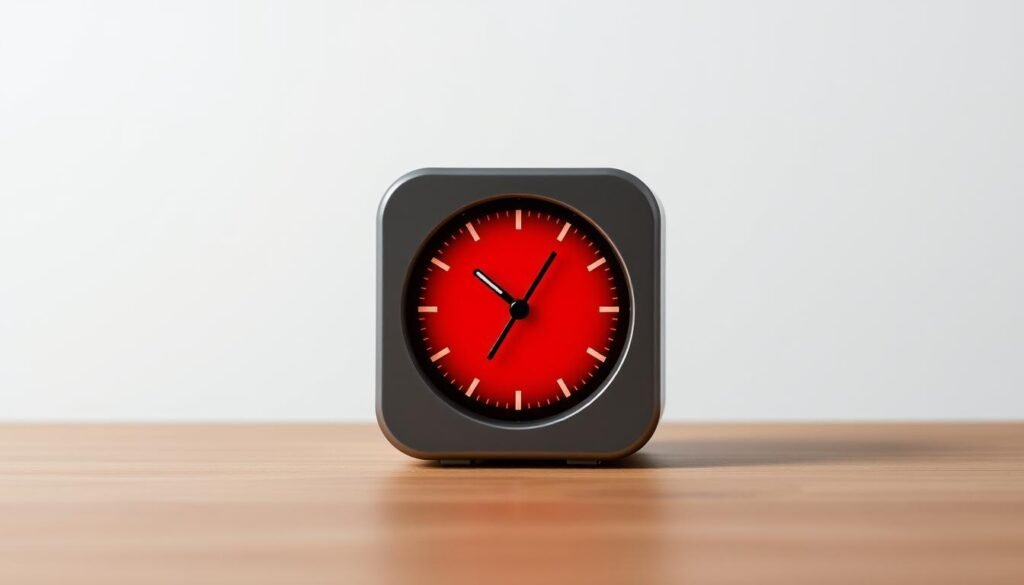Effective time management is crucial in today’s fast-paced world. The average worker is productive for less than three hours a day. This means they work less than 15 hours in a 40-hour workweek1.
Distractions like emails and multitasking can reduce productivity by up to 40%12. There’s no one-size-fits-all approach to time management. Experts suggest trying the Pomodoro Technique. It boosts productivity by 25% through focused work sprints and breaks1.
More than 70% of professionals feel overwhelmed by their work2. Tools like the Eisenhower Matrix or the 80/20 rule help focus on important tasks. Effective time management can reduce stress by 50% and increase job satisfaction by 20%2.
Begin by finding the time management technique that fits your style. Whether it’s time blocking like Elon Musk or the GTD method’s five-step process3. Each method aims to bring order to chaos.
Key Takeaways
- Effective time management increases productivity by focusing on 20% of tasks that yield 80% of results3.
- The Pomodoro Technique improves focus with 25-minute work sprints and breaks12.
- Multitasking reduces productivity by up to 40%—single-tasking instead12.
- Time management training cuts stress by 50% and boosts goal achievement2.
- Over 70% of workers feel overwhelmed—these strategies can turn the tide2.
Understanding Time Management Techniques
Every day has 24 hours, but how you use them shapes your success. Time management strategies turn scattered efforts into clear goals. By focusing on priorities, you can improve productivity and reduce stress. Proper planning ensures no minute goes to waste.
What is Time Management?
Time management is organizing daily activities to align with goals. It’s about choosing what to tackle first. Stephen Covey’s matrix splits tasks into four groups: urgent/important, not urgent but important, urgent but not important, and neither. This system helps decide where to focus first4.
| Priority | Task Type |
|---|---|
| 1 | Urgent & Important (e.g., deadlines) |
| 2 | Not Urgent but Important (e.g., long-term goals) |
| 3 | Urgent but Not Important (e.g., interruptions) |
| 4 | Neither (e.g., social media scrolling) |
The Importance of Efficiency
Efficiency means working smarter, not harder. Students using time logs cut wasted time by tracking 15-minute blocks4. Research shows multitasking drops productivity by splitting focus4. Effective strategies like the 5 Ps—Plan, Prioritize, Use Tools, Avoid Procrastination, Protect Personal Time—build habits that boost results5.
Efficiency reduces stress and improves work-life balance. Those mastering these skills gain free time for hobbies or rest4. Start by listing daily tasks and ranking them by impact. Small changes, like setting daily goals, multiply over weeks, leading to long-term success5.
Identifying Your Productivity Style
Knowing your unique work style is key to better productivity. Research points to four main styles: Prioritizer, Planner, Arranger, and Visualizer6. Each style does best in its own way. Take an 84-question test to find out your natural style6.
Visualizers, for example, do their best in 20-30 minute creative bursts7. Planners, on the other hand, like detailed plans to keep track of their tasks6.
Discovering Your Work Habits
Find out when you’re most alert. Morning people might do well with morning work blocks8. See if you tackle big tasks first or break them into smaller tasks7.
Prioritizers send quick replies, while Arrangers need social interaction to stay motivated6. These hints show your best work flow.
Adapting Techniques to Fit Your Style
Use time management that fits your strengths. Visualizers like color-coded planners, while Planners do well with daily lists6. Try the Pomodoro Technique with short breaks after hard work7.
Experiment with mixing methods like “Eisenhower Matrix + To-Don’t Lists” to match your energy8. The goal is to find what works for you. Daily 90-minute blocks for important tasks are best during your peak focus times7.
The Eisenhower Matrix: Prioritizing Tasks
The Eisenhower Matrix was created by President Dwight Eisenhower. It helps you prioritize tasks by sorting them into four categories. These categories are based on urgency and importance. This time management technique helps you focus on what’s most important.
understanding urgency vs. importance>Tasks fall into four quadrants: Do (urgent & important), Schedule (important but not urgent), Delegate (urgent but not important), and Delete (neither urgent nor important)9. It’s important to note that urgent tasks often don’t help you reach your long-term goals10.
| Quadrant | Action | Examples |
|---|---|---|
| Do | Handle immediately | Deadlines, emergencies |
| Schedule | Plan for later | Strategic planning, skill development |
| Delegate | Assign to others | Email replies, routine reports |
| Delete | Eliminate or reduce | Social media, trivial meetings |
how to use the matrix effectively>Begin by making a list of your daily tasks and categorizing them. Spend most of your time in Quadrant 2 (Schedule), where you do proactive work for long-term success11. Limit each quadrant to 8 items to avoid feeling overwhelmed9. Use colors like green for “Do” and yellow for “Schedule” to see your priorities11. Regularly check your matrix to remove activities that waste your time10.
Many people waste time on tasks that are urgent but not important. This can hurt your productivity10. By using the matrix, you can improve your focus and efficiency by up to 25%10. It’s a flexible tool for both work and personal life, helping you stay focused on what’s truly important.
The Pomodoro Technique: Work in Bursts

The Pomodoro Technique is a way to manage time by breaking work into focused periods. It was developed by Francesco Cirillo in the 1980s12. It involves working in 25-minute blocks, followed by a 5-minute break12. After four cycles, a longer break of 15–30 minutes helps you recharge12.
This method helps fight mental tiredness and boosts creativity with regular breaks13.
Benefits of Timed Work Sessions
Short breaks can boost your energy and prevent burnout13. Studies show that breaks under 10 minutes can improve focus and productivity13. The Pomodoro Technique helps by dividing tasks into manageable parts. This makes big projects seem less overwhelming and helps you avoid putting things off.
| Step | Description | Time |
|---|---|---|
| 1 | Work uninterrupted | 25 minutes12 |
| 2 | Take a 5-minute break | 5 minutes12 |
| 3 | Repeat steps 1–2 four times | 100 minutes total work |
| 4 | Long break (15–30 minutes) | Post-cycle recovery12 |
Tips for Successful Pomodoro Implementation
Use apps like Clockwise to help with breaks and stay focused13. Keep track of your Pomodoros to plan your time better12. You can adjust the time for different tasks, like 50-minute work sessions with 10-minute breaks. Turn off notifications to avoid distractions during your work time.
This method works well for all kinds of work, from creative projects to office tasks. Use digital calendars to keep your schedule consistent13. It balances work and rest, improving your focus and efficiency naturally.
Setting SMART Goals for Success
Effective time management starts with clear goals. SMART goals—Specific, Measurable, Achievable, Relevant, and Time-bound—are proven to improve productivity by aligning daily tasks with long-term aims14. Without clear goals, teams often struggle to define success, leading to wasted effort14. Let’s break down how each component works.
Breaking Down SMART Components
Specific goals answer what, why, and how. For example, “Increase app users by 1,000 monthly” clarifies the target and steps, like focusing campaigns on Facebook, Twitter, and Instagram14. Measurable targets let you track progress, like tracking user growth weekly. Achievable goals consider resources; Jane reduced platforms from four to three to stay realistic14.
Relevant goals link to bigger goals, such as boosting app engagement to increase profitability14. Time-bound deadlines, like hitting targets by Q1 2022, prevent procrastination14. Over 90% of users report clearer focus when using SMART goals15.
Tracking Progress Toward Your Goals
Writing goals down boosts success by 42%16. Regular check-ins let you adjust plans—like Jane shifting platforms. Tools like calendars or apps help track milestones, reducing stress for 50% of professionals15.
Celebrate small wins to stay motivated. Effective time management thrives when goals guide daily choices, turning big ideas into actionable steps.
Leveraging Technology for Time Management
Today, time management techniques are enhanced by digital tools. Apps like Asana and Trello help teams see their work flow clearly. This reduces confusion and increases focus. McKinsey found that collaboration tools can make tasks 30% more efficient17.
But, it’s important to pick the right tools without making things too complicated.
Apps That Can Help
Apps like Trello and Todoist18 break down big projects into smaller steps. Tools like Zapier automate tasks, saving 28 minutes a day18. Using AI calendars like Google Calendar can cut down on scheduling conflicts by 20%19.
| Tool Type | Examples | Key Benefits |
|---|---|---|
| Task Managers | Asana, Trello | Visual task tracking18 |
| Automation | Zapier | Reduces manual work18 |
| Calendars | Google Calendar | Automated scheduling19 |
| Communication | Slack, Microsoft Teams | Cuts meeting time by 15%19 |
Digital Calendars: Staying Organized
Google Calendar and Microsoft 365 help set aside time for focused work. Companies using these tools see a 28% drop in unproductive email time17. Using apps like Focus@Will can also improve concentration during work sessions19.
Setting up smart tools can reduce distractions. For example, Microsoft’s Focus Assist can silence distractions during deep work19. But, too many apps can actually make things worse, turning tech into a time sink17.
Overcoming Procrastination
Procrastination hits 70-95% of students, making it a big challenge for time management skills20. Many fear failure or feel too much pressure to be perfect20. But, science has proven to help take back control.
Identifying Causes of Procrastination
Research finds 85% of students procrastinate due to fear of failure, and 70% because of perfectionism20. About 20% of people struggle with chronic procrastination, often due to self-doubt21. Stress and low self-esteem also contribute21.
Strategies to Stay Focused
Breaking tasks into smaller steps can boost productivity by 50%20. Using rewards (temptation bundling) keeps you moving. Setting goals can increase on-time task completion by 30%22. Try these to improve your workflow:
| Strategy | Impact | Reference |
|---|---|---|
| Task Decomposition | 50% productivity gain | 20 |
| Goal Setting | 30% on-time completion | 22 |
| Flexible Scheduling | 40% task completion boost | 22 |
| Positive Self-Talk | 35% procrastination reduction | 20 |
Using these strategies together makes staying focused easier. Learning turns procrastination into progress, step by step.
Creating a Productive Work Environment
Turning your workspace into a productivity hub is easy. A messy desk or digital files can slow you down. Studies show 71% of workers feel disorganized spaces hurt their work23. Cleaning your desk or clearing your email inbox can help you focus better.
Organizing Your Workspace
Start by spending five minutes each day to organize your stuff. Clutter can make you stressed and less able to make decisions23. Use drawer dividers and labels to keep things tidy. For digital files, use folders like “Urgent Projects” and “Archive” to help you stay on track. Tools like Basecamp or Microsoft Outlook can help manage your work24.
Minimizing Distractions
Reduce noise with headphones or apps that play white noise. Try not to check emails or chats too often. A study found 43% of workers get distracted easily23. Use browser extensions like Freedom to block sites that distract you. Also, work in 15-minute bursts to stay focused23.
| Physical Environment | Digital Environment |
|---|---|
| Adjust ergonomic chair/monitor | Use task management apps |
| Place plants to improve air quality | Set daily to-do lists |
| Use cable management systems | Automate repetitive tasks |
Small changes can make a big difference. A well-organized space helps you manage your time better. It can make you 20% more productive23. Keep your space organized to stay focused all day.
Building Consistent Routines
Routines make time management habits that last. They automate daily choices, easing mental stress. Tools like digital calendars help turn goals into action25.
The Power of Habit Formation
Small habits can make a big difference. Routines lead to 30% less decision fatigue and 25% more productivity25. Start by linking new habits to daily actions, like checking tomorrow’s tasks over coffee.
Time audits show 21% of workday focus time is often wasted without plans26. Tools like Trello or Google Calendar track patterns. The NICE framework keeps goals achievable26.
Examples of Effective Daily Routines
Designers block 30 minutes for top tasks at the start. Writers batch emails in fixed times. Early risers have a 20% edge on daily goals, and digital decluttering saves 2 hours weekly25.
Use the Pomodoro Technique for work and breaks, then review your evening. Buffer time for unexpected tasks keeps things flexible—like the 12% of workday breaks that recharge focus26.
Great routines adapt to life’s changes. Combine tools like calendar apps with habits like weekly reviews. Remember, it’s consistency, not perfection, that makes techniques like the Eisenhower Matrix work daily26.
Your routine is your roadmap—keep refining it until it fits your pace26.
FAQ
What are the best time management techniques to boost productivity?
How do I know which time management strategy is right for me?
What is the Eisenhower Matrix and how can it help me?
Can the Pomodoro Technique really improve my focus?
How can I track my progress towards my goals effectively?
What technology can help me manage my time better?
How do I combat procrastination effectively?
What should I consider when creating my workspace?
How can routines improve my time management skills?
Source Links
- 8 time management tips for productivity – https://slack.com/blog/collaboration/8-time-management-tips-for-productivity
- 26 Most effective time management techniques — Clockify – https://clockify.me/time-management-techniques
- 9 Popular Time Management Techniques and Tools | USAHS – https://www.usa.edu/blog/time-management-techniques/
- Time Management: 10 Strategies for Better Time Management – https://extension.uga.edu/publications/detail.html?number=C1042&title=time-management-10-strategies-for-better-time-management
- Time Management Strategies: 8 Tips for Balancing College and Life – https://www.snhu.edu/about-us/newsroom/education/time-management-strategies
- How To Define Your Productivity Style [Full Guide] – Luxafor – https://luxafor.com/how-to-define-your-productivity-style-full-guide/?srsltid=AfmBOoohmfZ3rhM-Va_0vZdyW40k-6D8VM5JNKMMw-Dz4S0ANcQlk4tr
- Productivity Best Practices for Your Productivity Style – Part 1 – https://www.linkedin.com/pulse/productivity-best-practices-your-style-part-1-carson-tate
- How to Identify Your Optimal Productivity Style – https://thomas-oppong.medium.com/how-to-identify-your-optimal-productivity-style-b15e70e0434c
- The Eisenhower Matrix: Introduction & 3-Minute Video Tutorial – https://www.eisenhower.me/eisenhower-matrix/
- The Eisenhower Matrix: Prioritize Your Time on What Matters Most – Knock Down Silos by Slab – https://slab.com/blog/eisenhower-matrix/
- The Eisenhower Matrix: How to Prioritize Your To-Do List [2025] • Asana – https://asana.com/resources/eisenhower-matrix
- What is Pomodoro Technique time management? – https://www.techtarget.com/whatis/definition/pomodoro-technique
- How the Pomodoro Technique Works for Time Management? | Clockwise – https://www.getclockwise.com/blog/pomodoro-method-time-management
- How to write SMART goals (with examples) – https://www.atlassian.com/blog/productivity/how-to-write-smart-goals
- SMART Goals to Improve Your Time Management Skills – https://www.letsdive.io/blog/smart-goals-to-improve-your-time-management-skills
- SMART Goals for Time Management: Examples & Tips – https://www.memtime.com/blog/smart-goals-for-time-management
- Leveraging technology for efficient time management – https://vorecol.com/blogs/blog-leveraging-technology-for-efficient-time-management-8271
- 15 Essential Time Management Techniques For Peak Productivity – https://www.actioncoach.com/articles/time-management-techniques
- How can technology enhance time management skills in the workplace? – https://psico-smart.com/en/blogs/blog-how-can-technology-enhance-time-management-skills-in-the-workplace-13141
- Understanding and Overcoming Procrastination – https://mcgraw.princeton.edu/undergraduates/resources/resource-library/understanding-and-overcoming-procrastination
- Time Management and Procrastination – https://caps.ucsc.edu/resources/time-management.html
- Effective Time Management for the Chronic Procrastinator – Elsevier Student Life – https://evolve.elsevier.com/studentlife/blog-post/time-management/
- 10 tips for mastering time management at work – https://slack.com/blog/productivity/time-management-tips-at-work
- Time Management in the Workplace: Strategies for Success – Global Ties U.S. – https://www.globaltiesus.org/time-management-in-the-workplace-strategies-for-success/
- How to Create Daily Routines for Time Management – Luxafor – https://luxafor.com/creating-daily-routines/
- How to build a time management routine – https://aliabdaal.com/productivity/how-to-build-a-time-management-routine/








GIPHY App Key not set. Please check settings